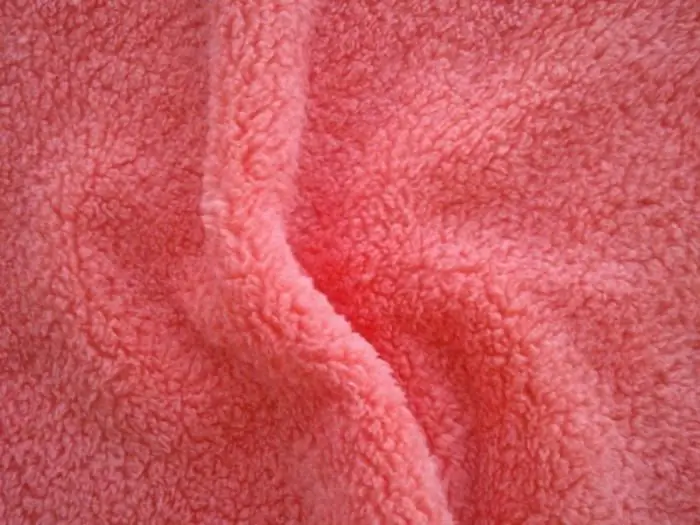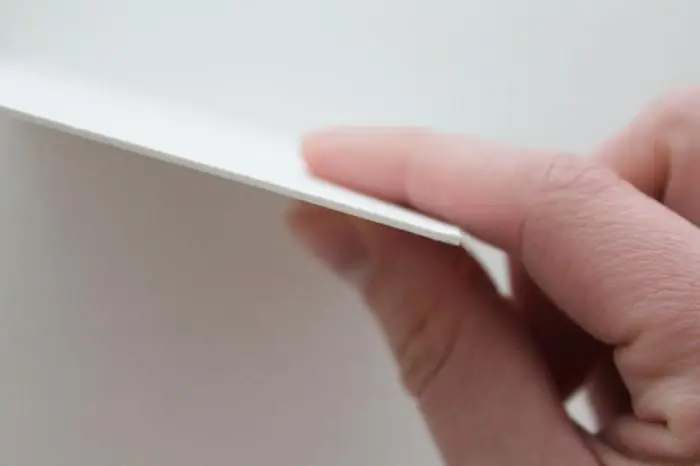2026 Author: Priscilla Miln | [email protected]. Last modified: 2025-01-22 17:55:23
Every person who at least once tried to sew a thing on their own faced the problem of deformation of fabric sections and individual parts of clothing. In order for the product to acquire an impeccable appearance, a special cushioning material is used in the sewing industry, which is called interlining.
What is the wonder material?
High-quality processing of sections of the lower edges of skirts and trousers, necks, turn-down collars can only be done with a good cushioning layer. Among non-professional tailors who are just starting to sew, there is an opinion that interlining is a fabric. This is actually a misconception.
Interlining is a non-woven cushioning material of white or yellowish color based on cellulose fibers. At the same time, the addition of polyester fibers is allowed. White is the most common color among interlining materials, but any shade can be chosen depending on the chosen fabric.

In its structure, interlining resembles paper. Depending on the purpose, the paper layer can be thin and weightless for light fabrics oras thick as cardboard to stiffen the stand-up collar or cuffs.
Due to the fact that an additional layer of matter is used when sewing the product, those parts of clothing that are usually easily deformed during sewing, as well as during further washing and cleaning, become stiffer and denser, do not stretch, and the appearance of the item remains impeccable.
Fleece is produced in rolls 100 meters long and 80 to 100 centimeters wide.
Types of interlining
The fibers from which interlining is made can be impregnated or not. Depending on this, two main types of gasket material are distinguished: adhesive and non-adhesive. The first is mainly used in tailoring various clothes. It is not removed, but remains on the fabric to give additional density to the details of the product.
Adhesive interlining is a non-woven fabric made of cellulose fibers, on which a layer of glue is applied. The adhesive coating can be continuous, like a film, and dotted. To give the details of the product rigidity, a dense interlining with a continuous coating is used. To keep the fabric light, but at the same time keep its shape, use a dot option.
Non-adhesive interlining can be water-soluble and tear-off. It is easily removed from the fabric, so it is more suitable for various types of creative work. It is also called interlining for embroidery. It is enough just to rinse the finished work - and the gasket material will dissolve in water. Or you can just carefully tear it off the fabric without damaging the embroidery.
Interlining can also be threaded. With this option, along the fiberscushioning fabric is located machine line. This gives the material extra strength.

If only a small area of clothing needs to be processed when sewing a product, then in this case it is better to use a non-woven edge. It consists of cuts of fabric with a width of 1 to 4 centimeters and is ideal for processing the lower sections of trousers and skirts.
Advantages and disadvantages
Like other types of interlining materials, interlining for fabric also has certain advantages and disadvantages.
The main positive point in using this type of cushioning fabric is its price. Unlike similar materials (for example, dublerin), interlining is relatively inexpensive. Depending on the type and density of the canvas, the price for it is from 20 to 50 rubles per meter.

Among the shortcomings are its fragility. With careless handling, non-woven fabric is easily torn. And if the cushioning material is dense, then the part of the product can become rigid, like plywood. In addition, despite the fact that interlining is not paper, it is wrinkled, and kinks and creases also form on it.
How to use interlining
Working with gasket material is not difficult, but in order for the product to have an impeccable appearance, you need to follow certain rules. Despite the fact that interlining is not a fabric, it is better to cut it along, like ordinary matter.
In order to glue the interlining fabric, it is necessary to attach it with a rough adhesiveside to the wrong side of the product and iron with a hot iron with steam through a piece of fabric. For things made of dense matter, the cut should first be wetted and only then ironed. And, conversely, non-woven fabric is glued dry with a hot iron to a light thin fabric. Press the iron against the fabric for no more than 10 seconds, otherwise the glue will show through on the front side.

Flizelin for fabric is used not only when sewing a product, but also in almost all types of creativity.
Interlining is an indispensable assistant in the sewing business. Affordable price, ease of use, good quality workmanship emphasize the advantages of this gasket material among other types and ensure its wide application.
Recommended:
Chiffon fabric: description, composition, properties and application

Chiffon allows you to create original and light models of dresses, blouses, shawls, scarves. Don't limit yourself to special occasions, chiffon outfits are great for everyday wear too. What is chiffon, its composition, how and with what to wear, which type is better to choose? Read about all this in the article
Flannelette fabric: description, composition, application

Flannelette fabric has been in demand for decades. The popularity of matter is due to its pleasant appearance and unique properties that cannot be compared with any other fabric. But like other fabrics, the bike has its pros and cons
Velsoft - what kind of fabric? Description and composition of velsoft fabric

The article describes the main characteristics, advantages and disadvantages of velsoft fabric. Successful examples of its application in knitwear production are given
Flannel: what kind of fabric? Characteristics, types, application, care

In the cold season, in bad weather, it is natural for a person to want to surround himself with soft, cozy, and most importantly, warm fabrics. Flannel is ideal for this purpose. What is the fabric? The question is perhaps redundant. But for those who do not know, this is a fairly dense material with a pile, which can be located both on both sides, and only on the wrong side
Density of whatman paper and other types of paper

The density of whatman paper or printing paper is very important. This criterion determines their scope, print quality and even the durability of the printer. What is the density of different types of paper, and how to choose the right one for a particular type of work?

